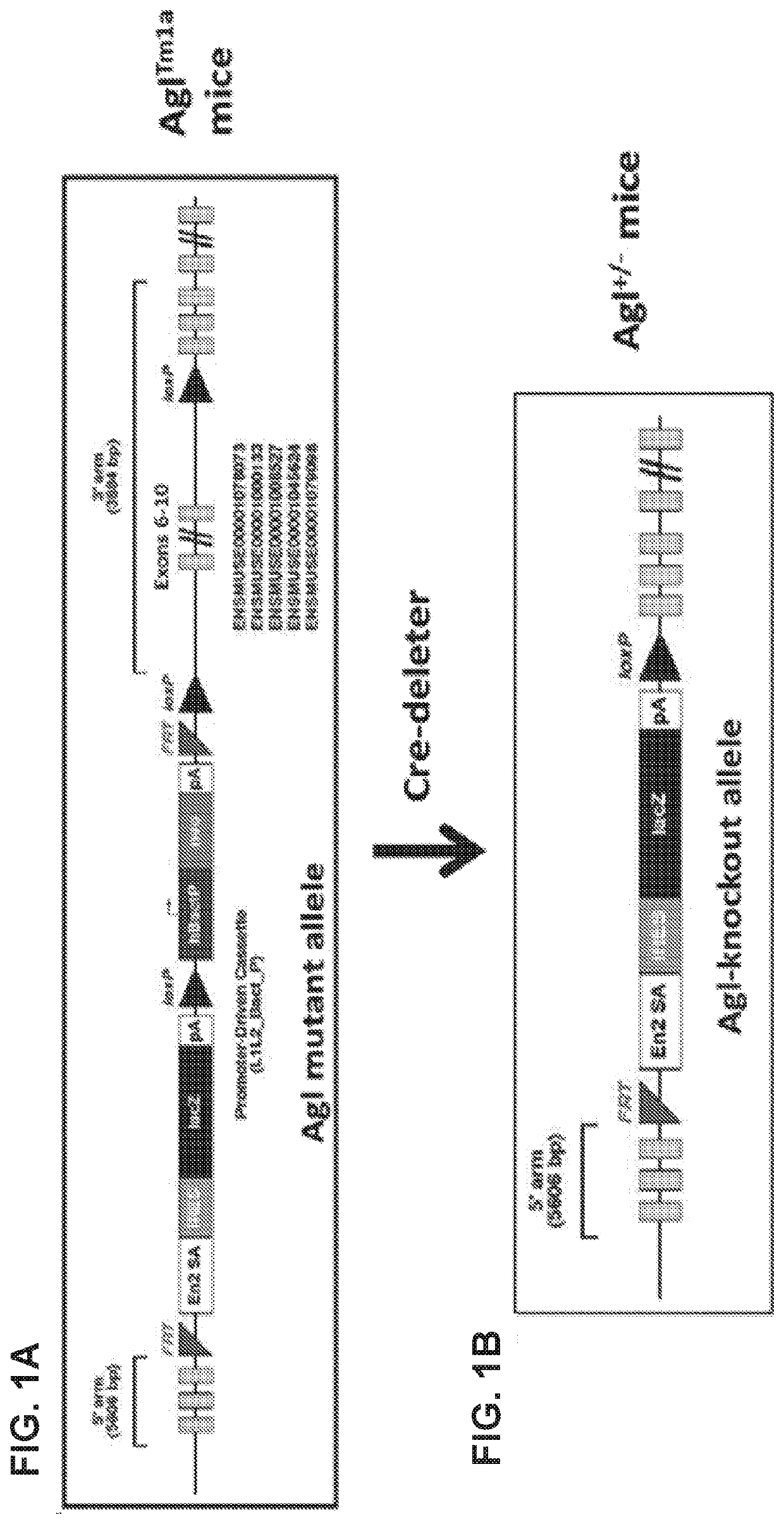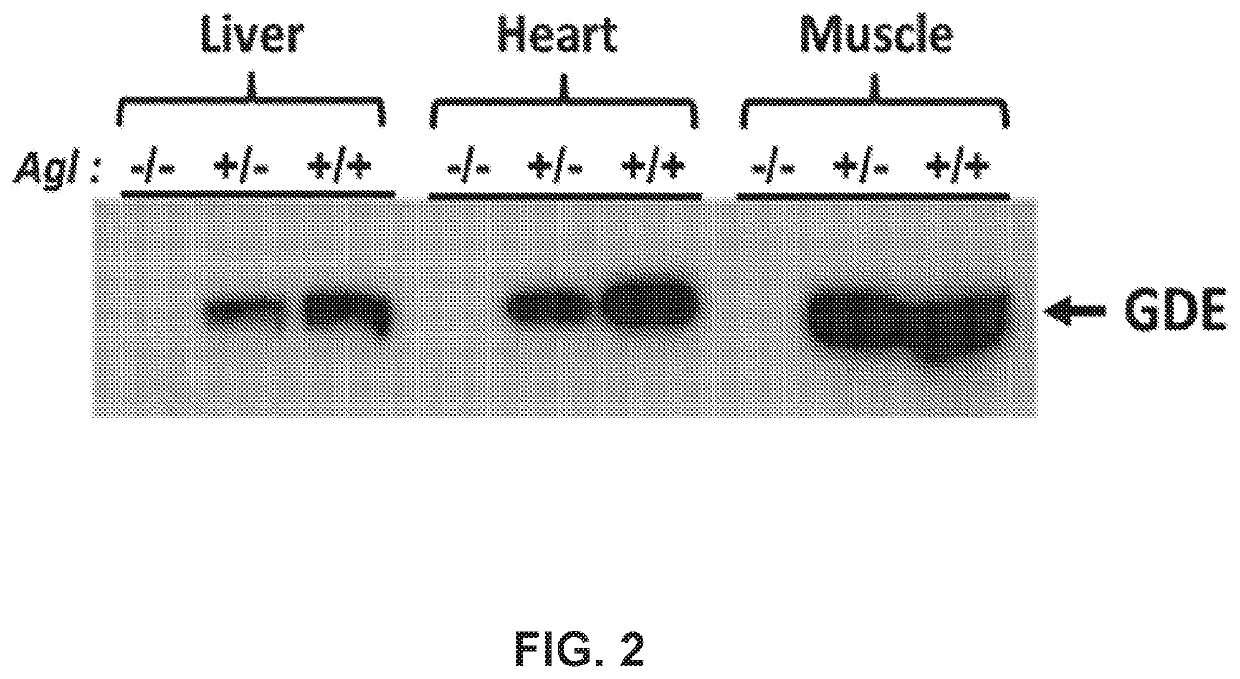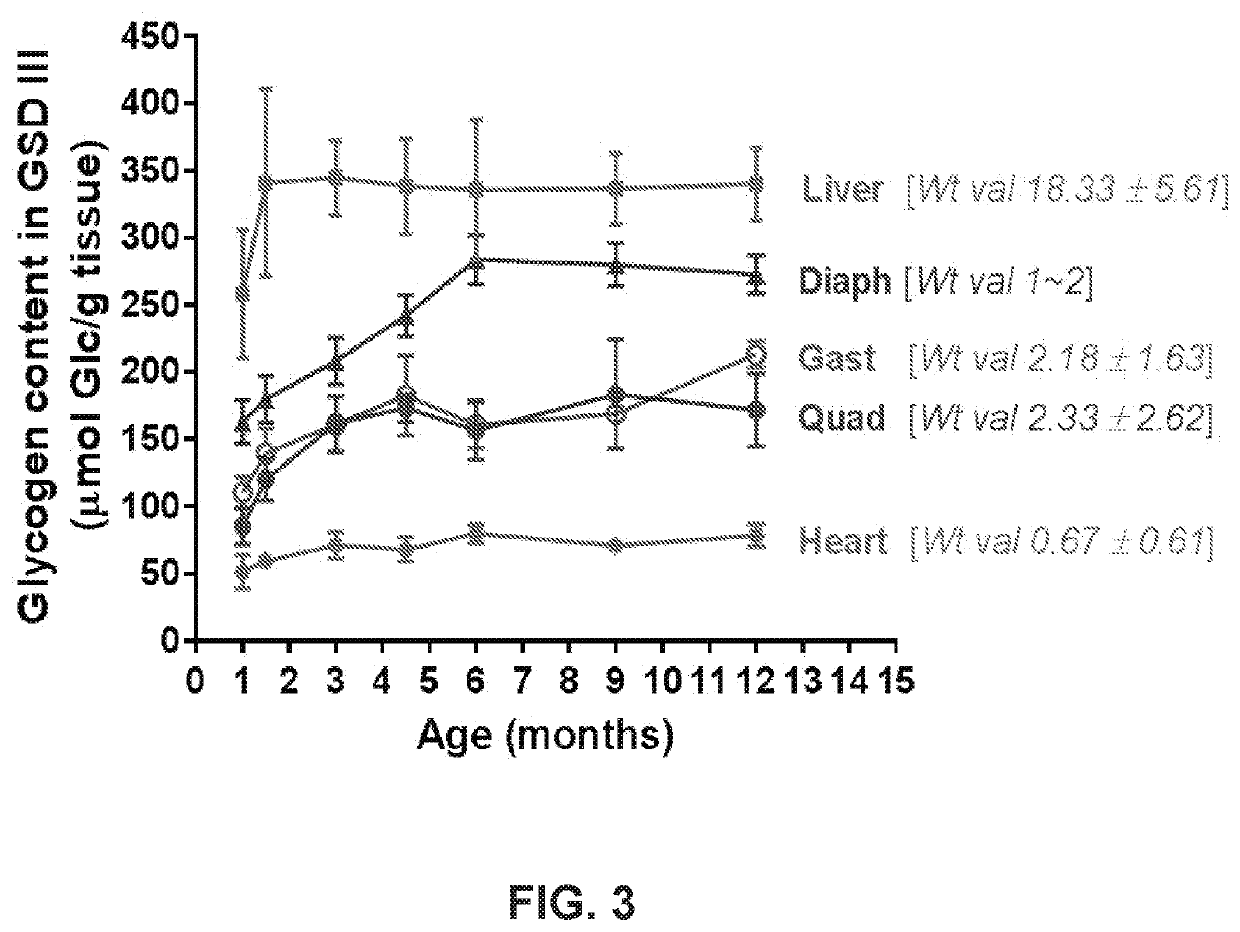Compositions and Methods for the Treatment of Genetic Diseases
a technology for genetic diseases and compositions, applied in the field of compositions and methods for the treatment of genetic diseases, can solve the problems of unable to deliver a gene expression cassette containing the large coding sequence of human proteins like human gde, accumulation of abnormally structured glycogen with short outer branches in multiple tissues, elimination of transgene-expressing cells after gene transfer,
- Summary
- Abstract
- Description
- Claims
- Application Information
AI Technical Summary
Benefits of technology
Problems solved by technology
Method used
Image
Examples
example 1
n of a Mouse Model of GSD IIIa
[0255]Heterozygous Agl mutant mice (AglTm1a) in the C57BL / 6N background that carry a mutant Agl allele (FIG. 1A) were purchased form the European Mouse Mutant Archive (EMMA) and crossed with the CMV-Cre mice (the Jackson Laboratory), to convert the mutant Agl allele into a knockout allele by deleting the exons 6-10 and the neo expression cassette (FIG. 1B). The resulting Agl+ / − mice were interbred to generate homozygous Agl− / −mice. Agl− / − mice were used as breeders to produce Agl-KO mice (Agl− / − or GSD IIIa mice in this disclosure). No GDE protein was detected in liver, heart, and skeletal tissue of the GSD IIIa mice (FIG. 2). PAS-stained tissue sections from 3-month-old GSD IIIa mice showed massive glycogen accumulation in the liver, heart, skeletal muscles (quadriceps, gastrocnemius, soleus muscle, tongue, and diaphragm) and smooth muscle (bladder), and significant amounts in the kidney and the entire region of the brain (data not shown). FIG. 3 shows...
example 2
n of Glycogen Accumulation in Liver of GSD IIIa Mice and GSD IIIa Dogs with the Liver-Targeted AAV-LSP-Pull Vector
[0259]In this experiment, the feasibility of using pullulanase-based gene therapy to reduce glycogen accumulation and the effectiveness of using a tissue-restricted gene expression approach to suppress pullulanase-induced cellular immune responses in GSD IIIa mice was tested. Ten-week-old GSD IIIa mice were intravenously injected with the AAV-CB-Pull or the AAV-LSP-Pull vector (both packaged as AAV9) at a dose of 5×1012 vg / kg and euthanized two and seven weeks later to collect tissues and blood. Age-matched untreated (UT) GSD IIIa mice and WT mice were included as controls.
[0260]At two weeks after AAV injection, the AAV-LSP-Pull treatment resulted in a significantly (2-fold) higher Pullulanase activity in the liver than the AAV-CB-Pull treatment (FIG. 5A), but both treatments dramatically reduced glycogen content in the liver by >90% (FIG. 5B). Light microscopy of PAS-st...
example 3
Gene Therapy with the AAV-CB-Pull Vector Achieved Long-Term Systemic Correction of Glycogen Storage in GSD IIIa Mice
[0266]Immune response is impaired in neonatal mice during the first few weeks after birth (Ramachandran, P. S., et al. (2017) Human Gene Ther., 28(2):154-167) and GSD animals often accumulate very low levels of glycogen in muscle tissues at this stage. The AAV-CB-Pull vector packaged as AAV9 was intravenously injected into 14-day-old GSD IIIa mice at a dose of 5×1012 vg / kg. Age-matched untreated mice were included as UT controls. All mice were euthanized 10 weeks after AAV injection following overnight fasting. The AAV treatment resulted in highly elevated Pullulanase activities in the heart and skeletal muscle (quadriceps) (FIG. 14A) and markedly reduced glycogen contents in these tissues (FIG. 14B). Consistent with measured glycogen contents, PAS stained tissue sections confirmed the clearance of glycogen accumulation in heart and skeletal muscle (FIG. 15). Plasma AL...
PUM
| Property | Measurement | Unit |
|---|---|---|
| debranching enzyme activity | aaaaa | aaaaa |
| nucleic acid | aaaaa | aaaaa |
Abstract
Description
Claims
Application Information
 Login to View More
Login to View More - R&D
- Intellectual Property
- Life Sciences
- Materials
- Tech Scout
- Unparalleled Data Quality
- Higher Quality Content
- 60% Fewer Hallucinations
Browse by: Latest US Patents, China's latest patents, Technical Efficacy Thesaurus, Application Domain, Technology Topic, Popular Technical Reports.
© 2025 PatSnap. All rights reserved.Legal|Privacy policy|Modern Slavery Act Transparency Statement|Sitemap|About US| Contact US: help@patsnap.com



